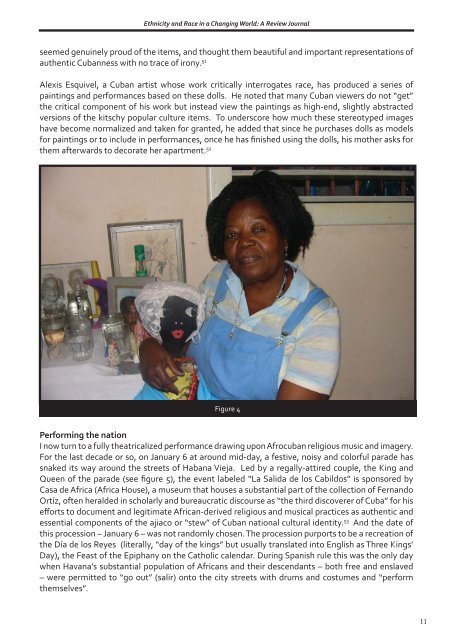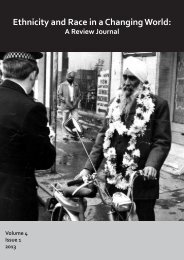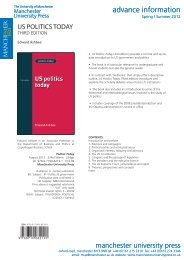<strong>Ethnicity</strong> <strong>and</strong> <strong>Race</strong> <strong>in</strong> a Chang<strong>in</strong>g <strong>World</strong>: A Review Journalflowers or fruits <strong>and</strong> bright smiles. Where the older women are stationary, planted <strong>in</strong> their spots,the younger women are mobile, approach<strong>in</strong>g tourists as they are disgorged from buses or simplyw<strong>and</strong>er<strong>in</strong>g on foot through the historic district, offer<strong>in</strong>g to pose for photographs for a small fee. Thesomewhat more abject or rebellious figures of the male slaves, usually <strong>in</strong> small ceramic figures orwooden carv<strong>in</strong>gs, do not have real-life counterparts outside of staged folkloric performances, manyof which <strong>in</strong>clude a choreographed set piece of a slave revolt, but the carved <strong>and</strong> pa<strong>in</strong>ted waiters <strong>and</strong>musicians come to life <strong>in</strong> tourist spots across the country. Hundreds of professional musicians – amajority of whom, for historic reasons, are Black men, all of whom are State employees – regalepatrons at <strong>in</strong>door <strong>and</strong> open-air bars, cafes <strong>and</strong> restaurants, while other men (<strong>and</strong> some women) –many of whom are Black - prepare <strong>and</strong> serve the food <strong>and</strong> dr<strong>in</strong>k that the patrons consume. 46While a full analysis of each of these iconic images <strong>and</strong> performances would be an <strong>in</strong>trigu<strong>in</strong>g <strong>and</strong>useful exercise, it is beyond the scope of this article. However, it is worth delv<strong>in</strong>g <strong>in</strong>to one commonfigure, the dark-sk<strong>in</strong>ned female cloth doll who looks like a Cuban counterpart to the “Aunt Jemima” or“mammy” dolls <strong>in</strong> the U.S., <strong>and</strong> who has a complicated legacy <strong>in</strong> Cuban popular culture. 47 The stout,dark-sk<strong>in</strong>ned woman wear<strong>in</strong>g a head wrap was a popular image <strong>in</strong> n<strong>in</strong>eteenth century marquillas,which are a rich source for study<strong>in</strong>g racial <strong>and</strong> gender ideologies <strong>in</strong> colonial Cuba. Well-known f<strong>in</strong>eartists such as Victor L<strong>and</strong>aluze created designs for many of the labels, <strong>and</strong> they blur the boundariesbetween high art <strong>and</strong> commercial culture. Although Jill Lane argues that Blackface m<strong>in</strong>strelsy wassometimes used for anti-colonial ends, the visual narratives <strong>in</strong> the marquillas often played outracialized fears about Cuba’s future <strong>and</strong> specifically the place of Blacks. 48 The dark-sk<strong>in</strong>ned womanor negra <strong>in</strong> the tobacco marquillas is often the mother of the light-sk<strong>in</strong>ned mulata, who is depictedas allur<strong>in</strong>g <strong>and</strong> highly desirable. She reflects a national racial/gender ideal. While the negra is thusimplicitly or overtly the sexual partner of a White man, she is never his wife, <strong>and</strong> the visual portrayal oftheir relationship sometimes suggests rape or seduction on the one h<strong>and</strong>, or a commercial transactionon the other. While the dark-sk<strong>in</strong>ned woman is thus shown as a sexual be<strong>in</strong>g (unlike some of the moredesexualized portrayals of dark-sk<strong>in</strong>ned Black women <strong>in</strong> U.S. popular cultural iconography), she isclearly less desirable than, <strong>and</strong> <strong>in</strong>ferior to, her lighter-sk<strong>in</strong>ned offspr<strong>in</strong>g. 49However, turn<strong>in</strong>g an ethnographic lens on how the dolls <strong>in</strong> circulation today are consumed, we f<strong>in</strong>dthat not all are purchased by tourists. I saw numerous dark-sk<strong>in</strong>ned female dolls with head wraps-- sometimes older, visibly careworn, <strong>and</strong> with less exaggerated features -- <strong>in</strong> the homes of Cubanfriends. In some cases they were simply decorative items, placed on crocheted doilies on a sofa orshelf, but often they were part of an altar for one of the African-orig<strong>in</strong> religions. In these contexts adoll may personify a person’s spirit guide <strong>in</strong> espiritismo (spiritism), one of the orishas <strong>in</strong> la regla deocha or santeria (the deities Yemayá <strong>and</strong> Oyá are both represented as dark-sk<strong>in</strong>ned Black women), ora similarly powerful female figure <strong>in</strong> Palo Monte. The dolls serve as entry po<strong>in</strong>ts for the div<strong>in</strong>e heal<strong>in</strong>genergies of these religious practices, <strong>and</strong> are thus sacred items. When I photographed my friendCaridad Moré, she chose to sit <strong>in</strong> front of her altar with one of her dolls <strong>in</strong> her arms (see Figure 4).As material cultural artifacts associated with African-orig<strong>in</strong> religions, older dolls which are no longerused for religious purposes have passed <strong>in</strong>to the collections of museums with ethnographic displaysdevoted to these religions such as the Historical Museum of Guanabacoa or Casa de Africa, becom<strong>in</strong>g“objects of ethnography.” 50 Their real-life counterparts are not limited to the self-exoticiz<strong>in</strong>g fortunetellers of Habana Vieja, but can be found <strong>in</strong> religious ceremonies, markets <strong>and</strong> households across theisl<strong>and</strong>.Aside from a few scholars <strong>and</strong> artists, few Cubans (<strong>in</strong>clud<strong>in</strong>g Black Cubans) seemed troubled by theseimages. They have become naturalized as part of the isl<strong>and</strong>’s visual iconography <strong>and</strong> abound <strong>in</strong> localdomestic material culture. An African American female scholar reported question<strong>in</strong>g some vendors<strong>in</strong> old Havana (while try<strong>in</strong>g to conceal her own troubled response to the images). She noted that they10
<strong>Ethnicity</strong> <strong>and</strong> <strong>Race</strong> <strong>in</strong> a Chang<strong>in</strong>g <strong>World</strong>: A Review Journalseemed genu<strong>in</strong>ely proud of the items, <strong>and</strong> thought them beautiful <strong>and</strong> important representations ofauthentic Cubanness with no trace of irony. 51Alexis Esquivel, a Cuban artist whose work critically <strong>in</strong>terrogates race, has produced a series ofpa<strong>in</strong>t<strong>in</strong>gs <strong>and</strong> performances based on these dolls. He noted that many Cuban viewers do not “get”the critical component of his work but <strong>in</strong>stead view the pa<strong>in</strong>t<strong>in</strong>gs as high-end, slightly abstractedversions of the kitschy popular culture items. To underscore how much these stereotyped imageshave become normalized <strong>and</strong> taken for granted, he added that s<strong>in</strong>ce he purchases dolls as modelsfor pa<strong>in</strong>t<strong>in</strong>gs or to <strong>in</strong>clude <strong>in</strong> performances, once he has f<strong>in</strong>ished us<strong>in</strong>g the dolls, his mother asks forthem afterwards to decorate her apartment. 52Figure 4Perform<strong>in</strong>g the nationI now turn to a fully theatricalized performance draw<strong>in</strong>g upon Afrocuban religious music <strong>and</strong> imagery.For the last decade or so, on January 6 at around mid-day, a festive, noisy <strong>and</strong> colorful parade hassnaked its way around the streets of Habana Vieja. Led by a regally-attired couple, the K<strong>in</strong>g <strong>and</strong>Queen of the parade (see figure 5), the event labeled “La Salida de los Cabildos” is sponsored byCasa de Africa (Africa House), a museum that houses a substantial part of the collection of Fern<strong>and</strong>oOrtíz, often heralded <strong>in</strong> scholarly <strong>and</strong> bureaucratic discourse as “the third discoverer of Cuba” for hisefforts to document <strong>and</strong> legitimate African-derived religious <strong>and</strong> musical practices as authentic <strong>and</strong>essential components of the ajiaco or “stew” of Cuban national cultural identity. 53 And the date ofthis procession – January 6 – was not r<strong>and</strong>omly chosen. The procession purports to be a recreation ofthe Día de los Reyes (literally, “day of the k<strong>in</strong>gs” but usually translated <strong>in</strong>to English as Three K<strong>in</strong>gs’Day), the Feast of the Epiphany on the Catholic calendar. Dur<strong>in</strong>g Spanish rule this was the only daywhen Havana’s substantial population of Africans <strong>and</strong> their descendants – both free <strong>and</strong> enslaved– were permitted to “go out” (salir) onto the city streets with drums <strong>and</strong> costumes <strong>and</strong> “performthemselves”.11






